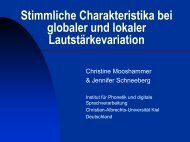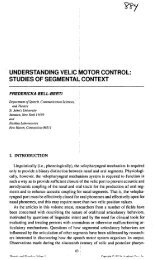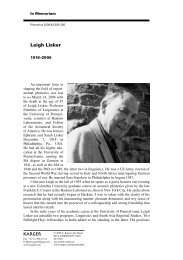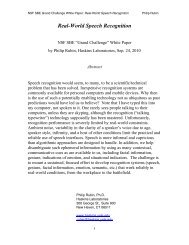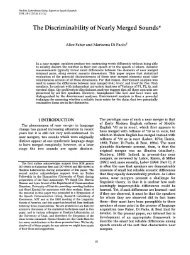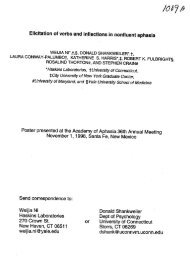Reception of Language in Broca's Aphasia* - Haskins Laboratories
Reception of Language in Broca's Aphasia* - Haskins Laboratories
Reception of Language in Broca's Aphasia* - Haskins Laboratories
You also want an ePaper? Increase the reach of your titles
YUMPU automatically turns print PDFs into web optimized ePapers that Google loves.
123<br />
words <strong>in</strong> the lexicon has been challenged on empirical grounds (see Gordon. 1983;<br />
Gordon & Caramazza. 1982). Though the notion <strong>of</strong> bifurcation <strong>of</strong> the lexicon may have<br />
to be abandoned. Bradley and her colleagues attempted to provide a compact<br />
explanation for the deficitS that commonly co-occur <strong>in</strong> Broca-type aphasia: both<br />
production and comprehension failures were seen as manifestations <strong>of</strong> impairment <strong>of</strong><br />
some <strong>of</strong> the procedures for lexical retrieval.<br />
It is worth not<strong>in</strong>g that the proposal <strong>of</strong> Bradley et al is consistent With the pOSSibility<br />
that syntactic knowledge is reta<strong>in</strong>ed <strong>in</strong> Broca-type aphasics who have comprehension<br />
difficulties. Difficulties would artse if the normal routes <strong>of</strong> access to stored l<strong>in</strong>guistic<br />
knowledge were blocked. Alternatively. the source <strong>of</strong> the difficulty could be at some<br />
post-syntactic level. Data address<strong>in</strong>g this issue were obta<strong>in</strong>ed by L<strong>in</strong>ebarger, Schwartz<br />
and Saffran (l983a). Dissatisfied with the ambiguity <strong>in</strong> <strong>in</strong>terpret<strong>in</strong>g the results <strong>of</strong><br />
commonly-used tests <strong>of</strong> comprehension, these <strong>in</strong>vestigators asked whether <strong>Broca's</strong><br />
aphasics are capable <strong>of</strong> construct<strong>in</strong>g syntactic representations by hav<strong>in</strong>g them judge<br />
the grammaticaUty <strong>of</strong> auditorily presented sentences. They found evidence <strong>of</strong> preserved<br />
sensitivity to transformational operations. subcategorization <strong>of</strong> verbs, and at least<br />
partial sensitivity to the syntactic functions <strong>of</strong> some closed-class vocabulary items.<br />
S<strong>in</strong>ce the aphaSiC subjects studied by L<strong>in</strong>ebarger et al. had been found to fail with<br />
regularity on sentence-picture match<strong>in</strong>g and act<strong>in</strong>g out tests, their success with<br />
grammaticality judgments came as a surprise to adherents <strong>of</strong> the asyntactic<br />
hypothesis. The f<strong>in</strong>d<strong>in</strong>gs seemed to fly <strong>in</strong> the face <strong>of</strong> previOUS research and theoriz<strong>in</strong>g<br />
which had sought to establish that a phonological or syntactic deficit was responsible<br />
for the sentence process<strong>in</strong>g difficulties <strong>of</strong> agrammatic aphasiCS. If the judgment task<br />
accurately reflects syntactic competence. then some component <strong>of</strong> language process<strong>in</strong>g<br />
at a higher level than the syntax must be responsible for errors that these <strong>in</strong>diViduals<br />
make on standard measures <strong>of</strong> sentence comprehension. 2<br />
In view <strong>of</strong> the importance <strong>of</strong> the questions raised by the f<strong>in</strong>d<strong>in</strong>gs <strong>of</strong> L<strong>in</strong>ebarger et al..<br />
the theory and methodology <strong>of</strong> comprehension test<strong>in</strong>g <strong>in</strong> aphasia is deservedly<br />
undergo<strong>in</strong>g thorough scrut<strong>in</strong>y (Caplan. 1985; Caramazza & Berndt, 1985; Kolk. Van<br />
Grunsven. & Keyser. 1985). Predictably; the conclusion that <strong>Broca's</strong> aphasics have<br />
reta<strong>in</strong>ed syntactic competence has not gone unchallenged (Caplan & Futter, 1986:<br />
Grodz<strong>in</strong>sky. 1986; Zurtf & Grodz<strong>in</strong>sky. 1983). The debate h<strong>in</strong>ges on the problem <strong>of</strong><br />
<strong>in</strong>ferr<strong>in</strong>g competence from various k<strong>in</strong>ds <strong>of</strong> test data. In deCid<strong>in</strong>g how claims about the<br />
source <strong>of</strong> comprehension failures should be evaluated. we must ask which tasks give an<br />
accurate <strong>in</strong>dication <strong>of</strong>where the problems lie. Although criteria for an adequate test are<br />
rarely specified. we suggest two. First. the task must allow one to draw <strong>in</strong>ferences about<br />
a s<strong>in</strong>gle level <strong>of</strong> process<strong>in</strong>g. ComprehenSion.tasks must be capable <strong>of</strong> teas<strong>in</strong>g apart the<br />
<strong>in</strong>dividual contribut<strong>in</strong>g factors <strong>in</strong> order to p<strong>in</strong>po<strong>in</strong>t the source <strong>of</strong> the problem with<strong>in</strong><br />
the language apparatus. A second criterion requires the task to reflect the rout<strong>in</strong>e<br />
operations <strong>of</strong> the language understand<strong>in</strong>g system. Let us see how exist<strong>in</strong>g<br />
comprehension tests measure up to these requirements. which we Will call the<br />
univocality criterion and the criterion <strong>of</strong> naturalness.<br />
These two criteria are <strong>of</strong>ten <strong>in</strong> competition, because we are try<strong>in</strong>g to disentangle<br />
factors that are <strong>in</strong>tertw<strong>in</strong>ed <strong>in</strong> ord<strong>in</strong>ary spoken communication. For this reason. some<br />
commonly used methods for assess<strong>in</strong>g comprehension fail to meet one or both criteria.<br />
For example. the method <strong>of</strong> sentence-picture match<strong>in</strong>g seems to satisfy the criterion <strong>of</strong><br />
naturalness. but it fails the criterion <strong>of</strong> univocality because it confounds syntactic and<br />
semantic process<strong>in</strong>g. The method <strong>of</strong> object manipulation confounds a third factor With<br />
these two. In addition to cartytng out a structural analYSis <strong>of</strong> a test sentence, a subject<br />
must formulate a plan for demonstrat<strong>in</strong>g his understand<strong>in</strong>g (see Hamburger & Cra<strong>in</strong>,<br />
1984. 1987. for data and discussion <strong>of</strong> the role <strong>of</strong> the plann<strong>in</strong>g stage <strong>in</strong> sentence<br />
comprehension). The univocality criterion will not be met <strong>in</strong> an object manipulation<br />
<strong>Reception</strong> <strong>in</strong> <strong>Language</strong> <strong>in</strong> <strong>Broca's</strong> Aphasia






